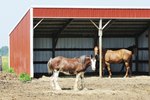Appearance and Size
Building a wooden horse fence is ideal for keeping livestock and for giving rural property that barn-country appeal. People have been building wood fences to mark their property and keep their horses for centuries. They are easy to repair and are sturdier than some other fences. Their natural appearance is also a nice way to integrate your fence with the landscape. A simple three-rail horse fence is built with materials such as 4-by-4 inch wood posts and 1 1/2-by-4 inch, 8-foot long rails. Fences generally measure 4 feet high to come up to a horse's chest area.
Construction
These fences are built by first digging post holes with shovels and post diggers. This is often the most grueling portion of the work. The holes are dug at least 12 inches into the ground so that the 5-foot posts become 4 foot posts when settled. The posts are spaced the appropriate distance apart, usually around 8 feet, and the three rows of rails are then nailed to the inside of the posts. One row is generally nailed just near the top so there are only a couple inches of post above it, and the other two rows are spaced accordingly so that one row is in each third of the fence's height. Galvanized nails are preferred, as they deter rust. Pressure-treated wood can be used to prolong the structure--though if you have a horse that is known to chew on wood fences, you may not want to have such chemicals in your wood fence.
Maintenance
Wood does eventually succumb to the elements and must be repaired from time to time, whereas vinyl fencing usually comes with a lifetime warranty when it is installed. Wood can attract termites and rot. Wood fences last longer if they are painted, sealing in the wood and protecting from moisture. Wood fences are cheaper to install and though they may not last you a lifetime, they are more natural than manmade materials--and you never have to worry about your fence cluttering a landfill one day.
Photo Credits
-
Kuperus Custom Fence, Inc.




